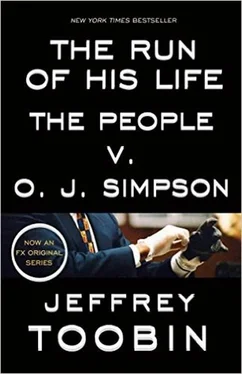Phillips called the hotel at 6:05 A.M. and asked to be put through to O.J. Simpson’s room. Though he recognized the voice, the detective still asked, “Is this O.J. Simpson?”
“Yes, who is this?”
Phillips chose his words carefully when he delivered news of Nicole’s death to O.J. “This is Detective Phillips from the Los Angeles Police Department. I have some bad news for you. Your ex-wife, Nicole Simpson, has been killed.”
Simpson was distraught. “Oh my God, Nicole is killed? Oh my God, she is dead?”
Phillips tried to calm him. “Mr. Simpson, please try to get ahold of yourself. I have your children at the West Los Angeles police station. I need to talk to you about that.”
“What do you mean you have my children at the police station? Why are my kids at the police station?”
“Because we had no place else to take them,” Phillips answered. “They are there for safekeeping. I need to know what to do with your children.”
“Well, I’m going to be leaving out of Chicago on the first available flight,” Simpson said. “I will come back to Los Angeles.” Phillips then handed the phone to Arnelle, who agreed with her father that she would ask his friend Al Cowlings to pick up the children.
Phillips never spoke to Simpson again. Later, the detective found it worth noting what Simpson did not say in their brief conversation. Simpson never asked how or when Nicole had been “killed.” Phillips had not said (and Simpson did not ask) whether she had been killed in an accident or a murder.

The drowsy children waited at the police station for someone to explain what had happened to them. At one point, eight-year-old Sydney Simpson asked to make a phone call, and she dialed her home number. The answering machine picked up, and Sydney left a message: “Mommy, please call me back. I want to know what happened last night. Why did we have to go to the police station? Please answer, Mommy. Please answer, Mommy. Please answer, Mommy. Please answer. ’Bye.”
The pace of events picked up quickly after Mark Fuhrman discovered the glove on the path behind Kato Kaelin’s room. After Phillips spoke to Simpson in Chicago, Tom Lange had the melancholy duty of notifying Nicole Brown Simpson’s parents of her death. LAPD policy called for detectives to notify a homicide victim’s next of kin in person if possible, but Lange learned from Arnelle that Lou and Juditha Brown lived in Orange County, about seventy-five miles away. Lange knew the media would soon learn about the murders and suspected that if he didn’t speak to Nicole’s parents immediately, they would learn of their daughter’s death from television news reports.
Lou Brown answered the telephone at 6:21 A.M. He took the news quietly. Lange did not know that Nicole’s sister Denise, the oldest of the four Brown daughters, lived at the family home and that she had picked up the phone on another extension.
Denise began screaming, “He killed her! He finally killed her!”
“Who?” asked Lange.
“ O.J.! ” said Denise.
Meanwhile, behind the house, Fuhrman quickly appreciated the significance of what he had found. The detective later recalled in testimony that “when I found the glove back here on this pathway, I will have to-I have to admit to you that the adrenaline started pumping because I didn’t really know what was going on… When I found the glove and actually realized this glove was very close in description and color to the glove at the crime scene, my heart started pounding and I realized what I had probably found.” One by one, Fuhrman took each of the other three detectives down the narrow pathway to study the glove without touching it. They all agreed that based on what they remembered, this right-hand glove looked like a match for the one at Bundy, but Vannatter sent Phillips and Fuhrman back to the murder scene to make a closer comparison. Lange would go back, too, to begin examining the evidence there, while Vannatter would await the criminalist at Rockingham.
The evidence stacked up quickly and led to a plausible theory of events: It appeared that the killer had dropped a left glove in a struggle at the murder scene and then suffered a cut on his exposed left hand. Bleeding, the killer then walked to a car in the back alley-very possibly Simpson’s Bronco. He then traveled to Rockingham where, perhaps in an effort to hide his clothes on the narrow path behind Kato’s room, he had dropped the other glove. “This is a crime scene,” Vannatter declared at Rockingham.
After the other three detectives left for Bundy, Vannatter decided to take a look around O.J. Simpson’s property. He stepped out the front door and onto the driveway, near the two parked cars. The sun was coming up at this point, and in the spreading daylight, Vannatter noticed what appeared to be a drop of blood on the ground. Then he found another… and another. The drops were all more or less in a row heading from the Rockingham gate to the front door. Vannatter opened that gate and took another look at the Bronco parked nearby. He stared in from the passenger side and noticed blood on the console between the two seats-and more blood on the inside of the driver’s door. Vannatter thought back to what he had seen at Bundy. The individual drops to the left of the bloody shoe prints leaving the two bodies resembled in size, shape, and color the drops here at Rockingham. Vannatter went back into O.J. Simpson’s home and found more blood drops in the foyer, just beyond the front door. The trail of blood now led right into Simpson’s home.
The criminalist, Dennis Fung, arrived at Rockingham at 7:10 A.M. and did a quick test of the red stain on the exterior of the Bronco. It was only a presumptive test, and so not 100 percent definitive, but it suggested the presence of human blood. Fuhrman returned from Nicole’s condominium a few moments later. He said the glove at Bundy was for a left hand, and told Vannatter that it did indeed look like a match for the right glove found behind Kaelin’s room.
That’s it, said Vannatter. We need to get a search warrant for this place. Vannatter left for the West Los Angeles station to write one up. Once there, he decided to touch base with deputy district attorney Marcia Clark. Vannatter and Clark had recently completed work together on a murder case that focused on blood and other trace evidence, and the detective wanted a second opinion on the facts he had gathered so far in this case. Checking with a prosecutor made sense for a detective; lawyers usually had better antennae than cops for determining whether a judge would grant a search warrant. For her part, Clark was only too pleased to receive Vannatter’s call at home shortly after eight on that Monday morning. A workaholic, and something of a crime junkie, she relished the details of criminal investigations as much as courtroom prosecutions.
Vannatter told Clark about the apparently matching gloves and then summarized the trail of blood-which wound from the left side of the shoe prints at Bundy, to the Bronco on Rockingham, to the driveway, and then to the foyer of Simpson’s home. Clark listened to Vannatter dispassionately and was struck only by one thing: the fancy neighborhood where the murders had taken place.
“Marcia,” Vannatter said. “It’s O.J. Simpson.”
“Who’s that?” Clark replied.
“You know, the football player, actor, Naked Gun .”
Marcia Clark had never followed sports. She went to the movies only once in a while. Just about her only connection to mass culture was when she listened to her Doors albums. For relaxation, she read novels about serial murderers.
Читать дальше













